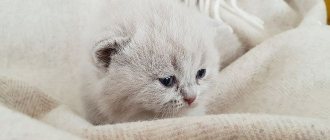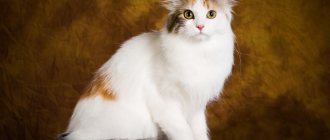History of the Thai cat breed
Thai cat
The National Library of Bangkok contains the manuscript “Book of Poems about Cats,” dating from the 14th-15th centuries, in which a breed similar to the modern one is mentioned in writing for the first time.
It was believed that Vichien Mae (as Thai cats are called in ancient manuscripts) lived only in royal palaces and Buddhist temples. Four-legged guards protected the chambers not only from evil spirits, but also from very real mice, rats and snakes, whose bites were harmless to cats due to the special properties of the skin: density, elasticity, minimal number of blood vessels and nerve endings, which reduced the pain threshold and prevented the spread of infection throughout the body. Cats with such outstanding features were carefully protected from strangers. It was strictly forbidden to export animals outside the kingdom of Siam. This attitude towards the Thais was the reason that they first appeared on the European continent only towards the end of the 19th century.
According to the official version, the first two cats of this breed were presented by the King of Thailand to the representative of the British diplomatic mission, Owen Gould, as a sign of the highest favor. Animals of unusual color created a sensation in the capital of the British Empire. Having learned about this success, the ruler of Siam, Chilalongkorn, sent several dozen purebred royal cats as a gift to high-ranking members of the British court. From that moment on, targeted breeding of the breed began in Europe.
In 1892, the first official breed standard for the Royal Siamese cat was defined. If you look through the records of the Thais of those times in the stud book of the Northern Cat Club (NCC), you will find the entry: “breeder - King of Siam.”
The popularity of the breed grew rapidly and reached its peak in America and Europe by the second half of the 20th century.
Thai kitten
The appearance of Siamese cats in Russia dates back to the same time. Breeding of the breed in the territory of the former USSR was practically uncontrolled, which led to its widespread distribution throughout the country. At the first exhibitions in Moscow and Leningrad, animals were exhibited in the “novice” category under the name “Old Siamese cat”.
In 1988, the president of the WCF (World Cat Federation), Anna-Lisa Hackman, having assessed the cats presented at Russian exhibitions, decided to create a new breed of “Thai cat”. The standard that is relevant today was first described in 1990, and registered by WCF in 1991.
Surprisingly, it turned out that the traditional Thai cat (despite the name) turned out to be an indigenous Russian breed.
Not so long ago, some twenty years ago, representatives of the breed were very popular. Gradually they began to be supplanted by the Persians, the British, and the sophisticated Siamese of European selection. However, there are still many connoisseurs of these magnificent animals who will do everything to ensure that the magical blue-eyed cats are not forgotten.
History of Tabby Point Breeding
This is one of the youngest colors, but it quickly gained popularity around the world. The appearance of the tabby point in Russia coincided with the development of another remarkable breed - the Neva masquerade cat.
In England, Thai breeding had been going on for a very long time, and by the mid-twentieth century, many of the famous colors were already known. The tabby point was born quite by accident.
In the nineties, work on breeding Thai and Siberian cats was carried out in a nursery in St. Petersburg. As it happened, there was an unplanned mating of different breeds of animals, and as a result, the most interesting kittens were born - some became the beginning of the Neva Masquerade breed, others became the first Thai cats with tabby color.
Appearance of a Thai cat
The standard approved in 1991 is currently under revision, so the breed is considered open. This means that any animal similar in phenotype to a Thai cat can be classified as a representative. To confirm such affiliation, it is necessary to have two expert signatures in the registration documents. Such animals are allowed for official breeding.
Head
Round, without pronounced angularities and flat fragments. The forehead is moderately convex, the transition to the nose is clearly marked and is level with the eyes, in no case below the conventional horizontal line running along the level of the lower eyelid. Stop is not observed. The muzzle is clearly marked, the cheeks are round, clearly defined in adult animals. Excessive plumpness is considered a fault. The nose is of medium length, straight.
Eyes
The eyes of Thai cats are slightly slanted (almond or lemon shaped) and large. The color of the iris ranges from sky blue to blue. A rich shade is valued more highly. Round or excessively slanted eyes lower the experts' ratings.
Ears
Thai ears are medium-sized, with a wide base and rounded tips. They are located widely on the head. Characterized by slight multidirectionality.
Neck
The length is closer to short. It is preferable for a cat to have a short neck.
Muzzle of a Thai cat
Torso
The body of the Thai cat is dense, muscular, but not massive. The chest is quite wide.
Legs and paws
The limbs are of medium length, proportional to the size of the body. Strong, muscular. The paws are round and small.
Tail
Hey man, let me in!
Thick at the base, slightly tapering towards the tip. Not long.
Wool
The Thai cat's coat is thin, short, smooth to the touch, adheres well to the skin, but is not “flat”. There is practically no undercoat.
Color
The determining factor in the phenotype of the breed is the acromelanic color, when individual parts of a generally light-colored animal have a contrasting dark shade (in the case of a Thai cat, paws, muzzle and tail). The gamma of the main tone suggests the corresponding colors of the mask and limbs. Dark fur on other parts of the animal's body, as well as visible light hairs or light spots on points, is a disqualifying factor.
Seal Point
This color is the most traditional and most common among Thai cats. The first “Thais” brought to Europe and exhibited in the Crystal Palace (London) were precisely “seal points”. Such cats have a whitish, soft beige, soft cream base coat tone and dark brown, or even almost black, dotted color.
Photos of Thai seal point cats:
Photo of a Thai cat
Rare colors
We looked at many varieties of “fur coats” of Thai cats, but we left the rarest and most expensive ones for last. Experts have identified the following variations:
- Cinnamon Point. This is a handsome guy with white fur without shades. The points are a cinnamon color, and the contrast of warm and cold looks very impressive.
- Caramel point. The fur is white, with a tint reminiscent of magnolia flowers. Caramel points (brown-gray). Stripes on marks are not welcome, but they do happen.
- Fawn point is a magical color! The base is like white magnolia, but shaded with soft tones of beige or pink-lilac. The points are also unique - pastel pink.
- Gray-brown point. This color is stunning in its contrast. The base is a pure white coat, without any shades, with clear markings of brownish-gray color, with a pink or purple tint.
Personality of the Thai cat
The ancient origin and special history of the relationship between Siamese cats and humans have left their mark on the character of the representatives of this breed.
Shall we chat?
The Thai cat is a true intellectual of the cat world. And it’s not just about the traditional cleanliness of these animals - many furry pets surprisingly quickly understand the essence of certain plumbing fixtures and begin to use them for their intended purpose, bypassing the traditional tray. And it’s not even that the Thai cat is an ideal object for training. The ability of an animal to understand people is amazing. Many believe that they received this skill from the monks of Siam. When she gets into your home, she will unmistakably identify the dominant member of the family and, with royal condescension, will count him among her favorites. This will not negatively affect relationships with other household members, but she will only wait and miss her “chosen one.”
Thais love to chat. Moreover, they do this with pleasure, if they just want to maintain a friendly conversation, or out of necessity, if they need to prove and explain something to the owner. The variety of intonations and sounds perfectly characterizes the state of your pet - he will come to thank you for a delicious dinner or express his displeasure with a long absence. At the same time, the Thai cat is sensitive to the mood of the owner - she can come to support you at the right time or, conversely, leave you alone with yourself.
Everyone, without exception, notes the curiosity of pets. Everything in the house will be examined and studied with special care. The statistics of cat injuries are directly related to this character trait. And if you lightly burn your nose with steam from a kettle or singe your mustache in the flame of a burning candle - it’s not so bad, then flying out of the window after a flying bird can end in disaster. Although even bitter life experience will not reduce the animal’s fearlessness.
The Thai cat always chooses a place in the house from which it can constantly control the situation. She loves active games, although she can also fool around with pleasure herself.
Thais are child friendly. You can safely leave your cat alone with even the smallest child. She will never let out her claws and certainly will not bite your baby.
For all their self-sufficiency, Thai cats are very affectionate creatures. She will tolerate a change of situation, and even short-term loneliness, if she is confident in your love.
Slender figure and relaxedness
In Thailand, it is almost impossible to meet a local woman in unattractive physical shape. All Thai women have slender, chiseled figures. This makes them look quite attractive to tourists visiting their country. Although Asian girls, in principle, are rarely overweight. Perhaps that is why the most beautiful Chinese and Japanese women come out on top in the sexiness ratings.
Thin beauties also have amazing plasticity and grace. It would seem that the Thai people seem to us to be fussy and nimble. At the same time, the girls of the Asian country know how to present themselves very elegantly.
They rarely wave their arms or gesticulate actively while talking. Thai women masterfully control their body and the ability to build tactile contact. Their touches are tender and are perceived by people around them as a sign of sympathy and friendliness.
Thai beauties use their advantage to earn money. It is known that, far from the resort areas of the country, local residents live in poverty. Several children are born in families. Therefore, older sisters have to move to tourist cities. There they make money in several ways. But the most common of them are massage and intimate services for visitors.
Thailand is a pretty loyal country. For the amusement of travelers, events are organized there that are difficult to even think about. Just look at the ladyboys, of which there are an incredible number in Pattaya and Phuket. The competition in the market for sexual services is so great that Thai girls have to work hard to ensure that their craft is in demand and brings in a decent income.
All over the world, Thai women are known as skilled lovers. Their talents in bed are associated with emancipation and the ability to completely surrender to the power of their partner. Thai massage skills play an important role. This is perhaps an even more common type of activity for Thai women. In most resorts on the planet you can see Thai massage parlors. Girls offer their services everywhere, including on popular beaches.
Upbringing
By the time they move to a new home, Thai kittens have already mastered the basic rules of behavior well and know how to use a scratching post and litter box.
To make the process of getting used to a new place of residence quick and painless, try to create an environment for your baby that is similar to the one in which he spent the first months of his life. Talk to your pet calmly, without raising your voice unnecessarily. A Thai will quickly understand that if they are dissatisfied with him and loudly scold him, then he has really done something wrong. Keep the use of harsh measures to a minimum. Aggression can only breed aggression. You can calm an overly angry cat with a stream of cool water. This is not painful or humiliating for the royal cat, unlike physical punishment. Provide your baby with enough toys. This will distract him from mischief and protect your things from damage. Keep valuable items and papers out of reach of the animal.
Having a cat in the house is both a great joy and a huge responsibility. And this responsibility lies with the individual.
Eternal youth3
With age, Thai women almost never gain excess weight. Their figure remains slim and attractive even after overcoming the fifty-year threshold. From the back, absolutely any Thai grandmother can easily pass for a young girl and attract the attention of many men.
Interestingly, Thai women are not very concerned about taking care of their skin. At the same time, it retains elasticity for many years. Perhaps this fact is related to their diet. Thais are famous lovers of spicy food and fruits. They drink about 3 liters of water per day. This habit leads to regular self-cleansing of the body. The skin receives a sufficient supply of moisture.
The basis of a Thai woman's daily diet is a large amount of fruits, seafood and, of course, rice.
Interestingly, Thais eat much more than the standard three times a day. Fractional and small-sized meals have a great effect on the metabolism in the body. This is the secret of long youth and a fresh appearance.
The sun's rays contribute to the rapid appearance of signs of aging. But, in the case of Thai girls, this rule is not very applicable. Their faces always shine.
Based on the points given earlier, we can conclude that Thais approach life much simpler than Europeans or Russians. An easy disposition and the ability to abstract from a problematic life have a beneficial effect on the appearance of local girls.
Care and maintenance
Siamese kitten
Caring for a Thai cat is not at all burdensome. Like a kitten of any breed, the little Thai must first of all be taught to use a litter tray and a scratching post. Kids are very smart and quickly understand what's what. Take a closer look at exactly where the kitten sharpens its claws most often, and place there either a store-bought device or a hand-made device made from thick fabric.
Curtains on the windows are very attractive to Thai babies, so for the first time tie them to a height inaccessible to the little prankster. Over time, they will become uninteresting to him, and the animal will direct its curiosity and activity in a different direction.
Your pet is unlikely to like the bathing procedure, but he will endure it with truly royal endurance. Make sure that water does not get into your ears during bathing procedures. Do not use “human” shampoos - there are enough specialized cosmetics on sale.
Caring for the fur of a Thai cat is extremely simple. It is enough to simply stroke your pet with a damp hand once a week to collect lost hairs. You can use a brush made of soft natural bristles or a special mitten - cats love massage, which, in addition to being cosmetic, also has a healing effect. A characteristic feature of the acromelanic color is its temperature dependence. The cooler the room where a Thai cat lives, the more active the age-related darkening of the coat occurs, which can negatively affect the exhibition career. The most problematic colors in this sense are seal point and blue point. The process can be slowed down if the animal is kept at an air temperature of +23 to +25 °C.
Only cats kept exclusively inside the house need to have their nails trimmed. This is done 2 times a month using a nail clipper or sharp nail scissors. Be careful not to damage living tissue with blood vessels.
Oral care involves periodically brushing your teeth and checking the condition of your gums. Performing this procedure periodically is advisable if you feed your Thai cat natural food.
Ears and eyes are cleaned as needed.
Feeding the cat
The two main rules are balance and sufficiency.
Kittens are fed 6-8 times a day in small portions, an adult animal receives food twice a day. Food should always be fresh, not cold or hot. Having a bowl of constantly clean water is a must.
I found my place in this house
Each owner decides the issue of balance independently. If at first you should follow the diet that the breeder followed, then in the future you can gradually transfer your Thai cat to a diet that will be more convenient for you.
There will be less hassle with ready-made feed. There is one “but” here - the widely advertised options from supermarkets are not suitable, otherwise health problems will arise. Use only specially developed premium and super-premium grades.
Supporters of a natural diet should remember that food from our table is not suitable for Thai cats. Your pet will have to cook separately. The menu must include raw meat, cut in such a way that the cat does not immediately swallow the piece, but chews it for some time. But be sure to cook the fish. Contrary to popular belief, it should not be made the dominant food product. Moreover, do not feed fish to a pregnant animal. Pamper your cat with a chicken egg once a week. Cottage cheese is welcome in the diet, but low-fat varieties are better. Hot and spicy dishes are excluded from the diet of Thai cats.
Vegetables and fruits can be given without restrictions - the cat will choose what she wants to eat at the moment.
If your Thai does not leave the house, make sure that her diet includes fresh grass or green cereals (seeds can be bought at a pet store and grown in ordinary flower pots).
When creating a menu, be sure to take into account the age of your pet - this will help avoid many problems. You can cook for cats only from fresh and high-quality products.
Where's my food?
Advantages and disadvantages
Like any breed, Thais have their own pros and cons. The advantages of these cats include:
- sociability;
- excellent communication skills with people and other animals;
- devotion;
- friendliness and lack of aggression;
- developed mind;
- good manners and ability to train.
But there are several disadvantages. These include an increased sense of revenge - a Thai cat will not tolerate bad treatment at all. These animals can also be called overly stubborn. If a kitten wants something, he will make every effort to achieve it.
Health and diseases of the Thai cat
The Thai cat received good health from its royal ancestors. Among other purebred animals, it is rightfully considered a long-liver: with an average life expectancy of 12-14 years, there have often been cases where a Thai has delighted his owners for more than two decades.
Strong immunity should in no case be a reason to refuse the necessary vaccinations, which must be done annually.
It would be naive to assume that Thai cats do not get sick at all. They have diseases of the gastrointestinal tract, liver, kidneys, and may have problems with the heart or teeth. But statistics show that the incidence of these diseases is no higher than in representatives of other breeds. The main thing is to carefully monitor the cat’s health. Timely adoption of the necessary measures plus the naturally good immunity will help to overcome all troubles.
The Thai cat is characterized by early puberty. Animals may be ready to mate as early as 4-5 months, but this does not mean at all that it is time to start mating. Such experiments can have an extremely negative impact on the condition of your pet, and you are unlikely to get healthy kittens. It is better to wait until the cat reaches one year of age.
Don't rush with sterilization. Such an operation should not be performed until the animal reaches six months of age. Some breed lines of Thai cats may be predisposed to developing mammary tumors. Veterinary practice shows that timely sterilization (up to one year) significantly reduces possible risks.
Genetic diseases of Thais can be considered convergent strabismus and tail defects. They are easily determined visually, although with the first problem everything is not so clear. The baby can “mow” temporarily, due to his tender age. If parents and grandparents are fine from this point of view, then most likely this is normal childhood strabismus. As you grow older, the deficiency will disappear. But there are times when this problem occurs in an adult cat. The most common cause is severe stress.
Development table
Every month, the kitten should periodically gain weight, which indicates its full development and good health. A weight table is a necessary diary kept by the owner of a growing animal. It is necessary to weigh the baby every week and compare its weight with the standard values for the breed.
| Age (months) | Weight, kg) |
| 1 | 0,4-0,5 |
| 2 | 1-1,2 |
| 3 | 1,4-1,7 |
| 4 | 1,8-2,4 |
| 5 | 2,2-2,9 |
| 6 | 2,5-3,3 |
| 7 | 2,6-3,7 |
| 8 | 2,7-4 |
| 9 | 2,8-4,1 |
| 10 | 2,9-4,2 |
| 11 | 3-4,3 |
| 12 | 3,1-4,5 |
A slight deviation up or down is normal, since each kitten develops individually. The weight of adult animals is 3-5 kg.
How to choose a kitten
Like any purebred animal, a Thai kitten must meet certain criteria.
- The acromelanic color does not imply the presence of white spots on the points. Carefully examine your chosen one.
- The kitten's tail should be smooth, without kinks or thickening.
- Make sure your baby doesn't have strabismus.
How to determine if your chosen one is healthy? The rules are simple. Firstly, by the age of three months (and earlier it is not recommended to take the kitten away from its mother), the breeder must give the baby all the necessary vaccinations, which is confirmed by the corresponding entries in the veterinary passport. Secondly, take the time to carefully examine the little Thai. The ears should be clean, the eyes should be free of signs of souring and streaks. The tummy of a healthy baby is painless and soft. The Thai cat pays very close attention to the hygiene of its children, and if the kitten’s tail is clean and dry, then it does not suffer from digestive problems.
The behavior of a little Thai can say a lot about both his health and character. An active cat eats well, shows its natural curiosity, is not afraid of strangers and boldly makes contact with people.
Even small Thai kittens can read people well. If the fluffy one has shown interest in you, and even more so happily climbed onto your lap, then you can rest assured that this is your cat.
Breed Features
The Thai cat breed is both elegant and powerful. Its representatives have developed muscles. The soft fur of these cats has virtually no undercoat. The average weight can vary from 4 to 10 kilograms. The character of Thai cats is very soft, they are smart and loyal to their owner.
However, with a bad attitude, cats can stand up for themselves, that is, “Thais” do not tolerate disrespect and behave with a person the same way a person behaves with them. They respond to love with affection, and to anger with aggression. Thai cat kittens are very nimble and playful. That is why a young pet will require a lot of care and attention from the owner.
Photos of Thai kittens
On
Thai woman named On (if I understood the name correctly). She is 20, her Facebook info confirms this, but she looks a little older. English is very weak. I took a long one from a go-go bar.
And there were many more secrets, there is no point in listing them all. I played pool with them, drank beer, had fun, didn’t think about anything.
Shots, buzz, young bodies, wild Asian eyes, sometimes frightening expressions, hot hugs, night, thundering music all around, alcohol, laughter, more games, speeding through the city at night on a motorbike, fresh wind in the face, swimming in the sea at sunset, dancing and passion - everything mixed up in these 2 weeks. A completely different life was in full swing, awakening youth, forcing me to enjoy endless bliss. Eternal and endless... forever.
I don't even remember their names.











